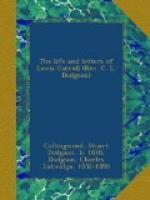He was always ready and willing to preach at the special service for College servants, which used to be held at Christ Church every Sunday evening; but best of all he loved to preach to children. Some of his last sermons were delivered at Christ Church, Eastbourne (the church he regularly attended during the Long Vacation), to a congregation of children. On those occasions he told them an allegory—Victor and Arnion, which he intended to publish in course of time—putting all his heart into the work, and speaking with such deep feeling that at times he was almost unable to control his emotion as he told them of the love and compassion of the Good Shepherd.
I have dwelt at some length on this side of his life, for it is, I am sure, almost ignored in the popular estimate of him. He was essentially a religious man in the best sense of the term, and without any of that morbid sentimentality which is too often associated with the word; and while his religion consecrated his talents, and raised him to a height which without it he could never have reached, the example of such a man as he was, so brilliant, so witty, so successful, and yet so full of faith, consecrates the very conception of religion, and makes it yet more beautiful.
On April 13, 1859, he paid another visit to Tennyson, this time at Farringford.
After dinner we retired for about an hour to the smoking-room, where I saw the proof-sheets of the “King’s Idylls,” but he would not let me read them. He walked through the garden with me when I left, and made me remark an effect produced on the thin white clouds by the moon shining through, which I had not noticed—a ring of golden light at some distance off the moon, with an interval of white between—this, he says, he has alluded to in one of his early poems ("Margaret,” vol. i.), “the tender amber.” I asked his opinion of Sydney Dobell—he agrees with me in liking “Grass from the Battlefield,” and thinks him a writer of genius and imagination, but extravagant.
On another occasion he showed the poet a photograph which he had taken of Miss Alice Liddell as a beggar-child, and which Tennyson said was the most beautiful photograph he had ever seen.
[Illustration: Alice Liddell as Beggar-child. From a photograph by Lewis Carroll.]
Tennyson told us he had often dreamed long passages of poetry, and believed them to be good at the time, though he could never remember them after waking, except four lines which he dreamed at ten years old:—
May a cock sparrow
Write to a barrow?
I hope you’ll
excuse
My infantile muse;
—which, as an unpublished
fragment of the Poet Laureate,
may be thought interesting,
but not affording much promise
of his after powers.




